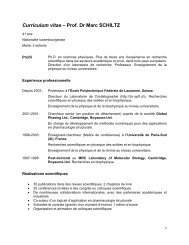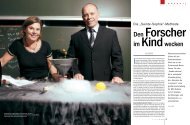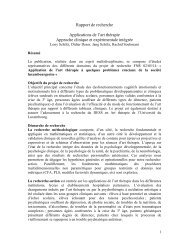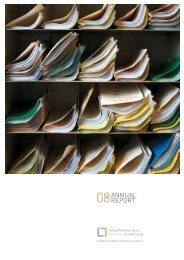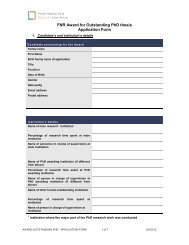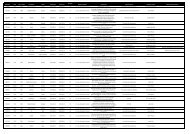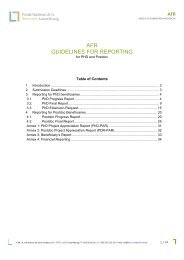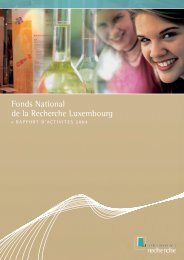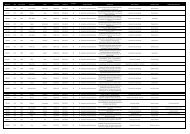CORE 2013 Application Guidelines - FNR
CORE 2013 Application Guidelines - FNR
CORE 2013 Application Guidelines - FNR
You also want an ePaper? Increase the reach of your titles
YUMPU automatically turns print PDFs into web optimized ePapers that Google loves.
<strong>CORE</strong><br />
MULTI-ANNUAL THEMATIC<br />
RESEARCH PROGRAMME<br />
Human resources<br />
Name of researcher Partner Qualification level Person*months<br />
PhD, post-doc, etc.<br />
6.3. Risk management and quality assurance (max. 1 page)<br />
Describe how you intend to ensure the quality of your work (e.g. definition of milestones for<br />
measuring project progress, regular joint progress evaluation, cross-checking of intermediate<br />
reports or results, etc.). Review the risks identified and describe how you will monitor and<br />
mitigate them. Mention any significant external factor (assumptions = positively phrased,<br />
risks = negatively phrased) that are not under the control of the project and may determine<br />
whether the intended project 1) may start as planned, 2) may be implemented as planned<br />
and/or 3) may achieve its intended objectives. (Example for an assumption: “Delayed<br />
equipment delivery.”)<br />
Please note: If serious risks exist (i.e. risks that could cause strong negative impacts and<br />
whose probability of occurrence is high), the project design should be reconsidered.<br />
In this section you should go beyond the description of how you want to tackle risks<br />
emerging in the project, e.g. regular consortium meetings.<br />
7. Project Outputs (max. 3 pages for 7.1 - 7.3)<br />
7.1. Contributions to advancement of knowledge, people and institutions.<br />
Summarise how the project outputs contribute to the advancement of the development of the<br />
scientific community of Luxembourg, in particular the participating partners’ organisations in<br />
terms of capacities, competencies, critical mass and international visibility.<br />
Describe:<br />
• the project’s contribution to the advancement of the state of the art, the knowledge<br />
production in the field and its dissemination to the scientific community,<br />
• the project’s contribution to training of young researchers, in particular that of PhDs,<br />
• how you will involve potential stakeholders from the private and public sector throughout<br />
the implementation of your project (if applicable),<br />
• the planned strategy for valorisation and dissemination of your results, if applicable (e.g.<br />
What are the expected results? What will be the strategy of protection (patent, trademark,<br />
design, copyrights? What will be the strategy of exploitation (licensing, start-up,…)?, what<br />
is the project’s potential to generate intellectual property and the possible exploitation of<br />
the IPR?<br />
• which efforts (publications, public conferences, and other activities) are foreseen in order<br />
to increase public awareness among the general public and the understanding of the<br />
research topic by a wider audience.<br />
Quantify these intended direct outputs of the project like PhDs, scientific publications, and<br />
other tangible outputs like prototypes, computer programmes, databases, etc. as far as<br />
possible in the table below.<br />
In some cases outputs (e.g., a publication) may be the result of one single work package,<br />
thus they will already have been mentioned above as “deliverables”. In this case repeat them<br />
here and refer back to the work package concerned.<br />
You will also have to decide what to include as a direct output in the present chapter and<br />
what to include as an intended medium to long-term impact in the chapter 5.2. For example,<br />
exploitation of IPR (in terms of licensing, patenting etc.) may either be part of your direct<br />
outputs or rather an impact that may eventually occur in the medium term, depending on the<br />
magnitude and the design of the proposed research project.<br />
<strong>FNR</strong> / 6, rue Antoine de Saint-Exupéry / B.P. 1777 / L-1017 Luxembourg / T +352 26 19 25 1 / F +352 26 19 25 35 / www.fnr.lu<br />
Last updated 12 December 2012<br />
31 of 46



